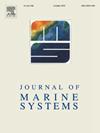Comprehensive analysis of marine heatwaves and ocean thermal structure impact on typhoon intensification in the East China Sea
IF 2.7
3区 地球科学
Q2 GEOSCIENCES, MULTIDISCIPLINARY
引用次数: 0
Abstract
This study utilizes satellite observations and high-resolution reanalysis data to investigate the potential mechanisms of typhoon intensification in the East China Sea (ECS) from 1993 to 2022. Oceanic and atmospheric conditions within the wind radii of 30 and 50 knots surrounding typhoons were analyzed. During the study period, 30 out of 91 typhoons traversing the ECS intensified. The results show that intensified typhoons typically experienced relatively warmer sea surface temperatures and higher average ocean heat content (OHC) than non-intensified typhoons. Intensified typhoons exhibited lower vertical wind shear and slightly higher relative humidity, which helped maintain storm structure organization and enhanced upper atmospheric moisture. However, variability among individual typhoons was significant. The analysis also indicates that these favorable thermal structures, characterized by high OHC, enhance typhoon intensity with only about 40 % probability. The mixed layer depth in the ECS is generally shallow, averaging less than 25 m, with minimal variation between intensified and non-intensified typhoons, making it challenging to use ocean stratification as a determinant for typhoon intensification. Furthermore, marine heatwave (MHW) events do not significantly alter the upper ocean thermal conditions during typhoon passage, indicating that typhoon intensification due to MHWs might be exceptional, with some typhoons potentially weakening as they encounter these conditions. This study underscores the difficulties of predicting typhoon intensity changes in the ECS's complex marine environment, posing ongoing challenges for coastal disaster management.
海洋热浪和海洋热结构对东海台风增强影响的综合分析
利用卫星观测资料和高分辨率再分析资料,研究了1993 - 2022年中国东海台风增强的潜在机制。分析了台风周围30节和50节风半径内的海洋和大气条件。在研究期间,91个台风中有30个台风增强。结果表明,与非强化台风相比,强化台风的海表温度相对较高,平均海洋热含量(OHC)较高。增强台风表现出较低的垂直风切变和稍高的相对湿度,有助于维持风暴结构组织和增强高层大气湿度。然而,个别台风之间的差异是显著的。分析还表明,以高热含量为特征的有利热结构增强台风强度的概率仅为40%左右。ECS的混合层深度一般较浅,平均小于25米,强台风和非强台风之间的差异很小,这使得使用海洋分层作为台风强度的决定因素具有挑战性。此外,在台风通过期间,海洋热浪(MHW)事件并没有显著改变上层海洋热条件,这表明由于MHW引起的台风增强可能是例外,一些台风在遇到这些条件时可能会减弱。这项研究强调了在ECS复杂的海洋环境中预测台风强度变化的困难,为沿海灾害管理带来了持续的挑战。
本文章由计算机程序翻译,如有差异,请以英文原文为准。
求助全文
约1分钟内获得全文
求助全文
来源期刊

Journal of Marine Systems
地学-地球科学综合
CiteScore
6.20
自引率
3.60%
发文量
81
审稿时长
6 months
期刊介绍:
The Journal of Marine Systems provides a medium for interdisciplinary exchange between physical, chemical and biological oceanographers and marine geologists. The journal welcomes original research papers and review articles. Preference will be given to interdisciplinary approaches to marine systems.
 求助内容:
求助内容: 应助结果提醒方式:
应助结果提醒方式:


